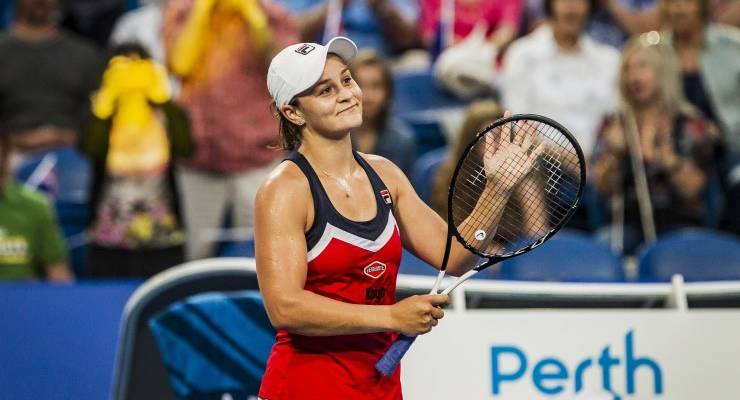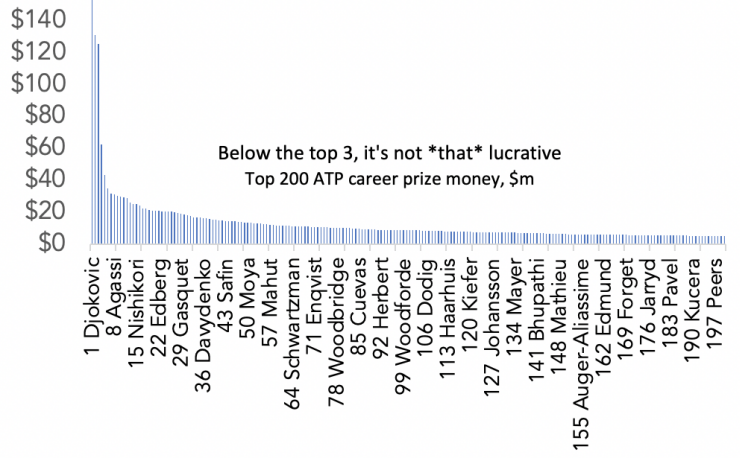
I get it. You’ve seen this new movie about the Williams sisters. You glance at the prize money earnings of the top tennis players at the Australian Open. A player can make $103,000 from losing in the first round of the Australian Open. “Wow!” you say. “And Novak Djokovic has pocketed $154 million in career prize money! Not bad work if you can get it.” You start to wonder if you should take your kids out on to a court and drill them until they become professionals.
But here’s the thing. Tennis is a terrible bet. You can become the best tennis player anyone you meet has ever seen, beat everybody you encounter, and still fail as a pro.
The 200th best doctor in the world is a life-saving hero with skill never seen before in their hospital. The 200th best lawyer in the world charges tens of thousands of dollars an hour. The 200th best tennis player, meanwhile, lives in three-star hotels, passes unrecognised on the street, and loses grim matches against upstarts from the former USSR to a total absence of applause.
Winner takes all
Professional tennis is an unflinchingly unfair endeavour. The division of prize money is not merely uneven, it’s insanely so. The gini coefficient of tennis — a measure of equality — is 0.95, making it far more unequal than the most unequal country in the world, South Africa.
The next chart shows the top 200 male tennis players by career prize money. Only three players have ever cracked US$100 million. Australia’s Powerball lottery has made far more people rich than the tennis tour. The top Australian in the list is Lleyton Hewitt, with US$21 million in prize money won over 18 years. Of current players, Nick Kyrgios is the highest, at 88, with US$9 million in prize money.

The tail of the distribution falls away rapidly. Only 700 men have ever made more than US$1 million from tennis prize money in history. That can be spread over a long career of grinding it out in the lower leagues. The annual costs of playing tennis are estimated at US$160,000 a year for a player aspiring to play worldwide.
The tyranny of ranking
Playing tennis for the love of the game is to be encouraged, of course. But the chance of making money? It depends on your ranking. The top 104 in the world get guaranteed entry to the grand slams (admittedly with some exceptions depending on the whims of immigration minsters). And if you lose in the first round of a grand slam, you get $103,000 in prize money, as we mentioned. The top 104 are therefore somewhat cushioned.
Outside the top 104, the financial pincers are eternally on you. You must spend money to travel to tournaments to build ranking points, and the structure of tournaments mean half the people who show up go home after just one match. Which they lost.
For example, 128 men showed up for the qualifying for the Australian Open; 64 of them played just one match before going home, taking $25,250 in prize money. That has to pay for their plane ride, their coach if they have one, accommodation, and access to courts so they can practise before their next tournament.
Another 32 players played two qualifying matches, lost the second one and went home, taking $35,500 in prize money. Only 16 qualify for the tournament. (Although a “lucky loser” from the final round of qualifying now slots in to the main draw with the departure of the world No. 1.)
Among those qualifiers, some will drop out of the world’s top 232 and therefore become ineligible to automatically play grand slam qualifiers. They must grind away at the lower levels to continue their career. The big money is in grand slams. Lose in the first round of an ATP Challenger tournament and you’ll get a mere $1000. That’s when the calculations get tough.
What about sponsorships in tennis?
Of course, prize money is not the only way for a tennis player to make money. Sponsorships are a highly visible part of the game. Uniqlo paid Roger Federer a staggering $300 million to wear its logo on court (triple what Nike had previously been paying him). He also shills for Credit Suisse, Mercedes Benz and Rolex. He’s worth billions. He’s also the anomaly — one of the most revered sportspeople of all time.
Sponsorship deals do not compensate for the inequality of tennis, they exacerbate it. They are even more crowded at the top of the distribution than is the prize money. Players outside the top 100 are lucky to get free shirts, shoes and racquets.
So how to invest this excess athletic ability?
Imagine you are gifted in hand-eye coordination and VO2 Max, and you wish to make money from this blessing. What sport should you choose? Individual sports are obviously not great. What about team sports?
Soccer is a clever choice. It has 65,000 professionals worldwide — some of whom earn money that would make Roger Federer faint. The 150th best soccer player in the world is making many millions of dollars a year. The English premier league alone has 550 players, and the lowest paid player for Everton makes 10,000 pounds a week. There are three more enormous football leagues on the European continent, plus dozens more worldwide where a soccer player can make it big. Even the humble A-League pays an average of $140,000 a year. (And unlike in tennis, you keep that money — soccer players do not pay for their own coach or training facilities!)
But soccer is a very competitive field. The ratio of professionals to amateurs is 1:3000. Is there a sport that does better? To answer this question we do not have to look far from home.
AFL teams are big. You need 18 players on the field at all times. And crowds are large. There’s money in this sport. The ratio of professionals to amateurs in men’s AFL may be the best in all pro sports: 700 professional men and (the AFL claims) 1 million amateur male players. That’s a ratio of professionals to amateurs of 1:1400. What’s more, if they get drafted by a local club, a fair few young AFL players can probably turn pro without even moving out of mum and dad’s house. And they can look forward to being paid an average $350,000 a year, with a much fairer distribution than you see in tennis.

The analysis above is for male sport. Women’s sport is very different. Indeed, women’s AFL players get a fraction of the pay of the men, while in the tennis grand slams pay is equal. In women’s sport, tennis is by far the most lucrative sport. Australia’s Ash Barty has won more than $20 million in prize money.
So as you enjoy the tennis this summer, respect the crazy financial risks the players and their families have taken, and remember — you’re far better off as a spectator.








Four years ago my family provided billeted accommodation to a 19 year old British women tennis player ranked in the high 200s when she played a local ITF event. She reached the semi finals and won about $2500. She spoke about how lonely it was out on tour trying to improve your ranking by travelling all over the world in an attempt to break into the Top 150 in the world (her short term goal). I asked her what she would do if she didn’t make it as a pro and she said she hadn’t given that possibility any thought. She broke into the top 200 the following year. I note that she is now ranked in the early 500s and has won just over USD 200,000 in career prizemoney. I didn’t envy her life one bit.
Interesting article. Any chance of a link to the data please?
This is the ATP prize money data (warning, very big pdf) : http://www.protennislive.com/posting/ramr/career_prize.pdf
Here’s the AFL pay data: warning, it’s an excel file) https://resources.afl.com.au/afl/document/2021/02/26/dd863c52-adb9-4251-92ba-db4b2a14679f/2020-Annual-Report-Total-Player-Earnings-Summary-of-AFL-Earnings-1-.xlsx
Thanks Jason. You moved from tennis to team sports without considering golf, I wonder how they compare?
My husband was a pro basketball player. He says the problem with team sports is that selection has favouritism and politics.
A shame that women’s sport only rated a throwaway paragraph at the end! Women make about 1/3 as much as men, $65k plus match payments. There is every chance that the women in AFL will make a third to half as much as men within a few years. Both are a better bet than tennis.
Sadly my daughter just wants to play hockey for Australia.